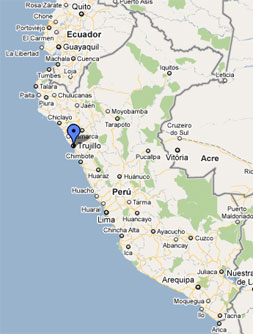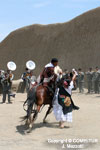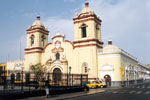About Trujillo City
Trujillo City is the capital of the department La Libertad, the third largest city in Peru. It was founded in the desert oasis valley of Moche by the Spaniard conqueror Diego de Almagro on December 6th, 1534 (before the foundation of Lima), located near Chan Chan, capital of the pre-Inca Chimú Nation, in a valley of great cultural hegemony.
Trujillo was the first important city of Peru that proclaimed its independence of the Spaniards on December 20th, 1820.
Until mid XX Century, the wealth of this town was given in the agricultural production and its export, and from then on it began the industrialization and the trade; prevailing the agricultural production of the sugar cane, rice, asparagus and tomatoes.
Very near the city you will find numerous and wonderful archaeological monuments of Mochica and Chimú cultures, outstanding Chan Chan's citadel, declared Cultural World Heritage Site by UNESCO.
Trujillo is known as the "City of Eternal Spring". Is also famed by the traditional celebrations of the National Contest of Marinera (Festival de la Marinera), the International Festival of Spring, competition of Peruvian Paso Horse, exhibition of "Caballitos de Totora", Biannual of Contemporary Art and International Festival of Ballet, for what is also called the "Cultural Capital of Peru".
The Huanchaco beach resort is only fifteen minutes away from the city. It is famous for the caballitos de totora, which are lightweight boats made of totora reeds that have been used to cut through the ocean since the time of the Mochicas and Chimús. There, you can enjoy exquisite seafood or simply bask in the glory of a day at the beach.
Trujillo, Lima and Ica are disputed to be the best worldwide breeders in the famous Peruvian Paso Horse.
Trujillo City Overview
-
Location:
North coast, 111.5 feet (34 m.) above sea level.
-
Distances to Trujillo:
-
Population:
751,961 inhabitants
Trujillo Guide
Historical Centre of Trujillo: Among 1685 and 1687, given the opulence of Trujillo, and due to the incursions of the pirates, the city was walled for its protection, and this enclosure constitutes today the historical centre where the colonial mansions of exquisite gates, wrought-iron window railings are a unique feature of the mansions, the convents and churches, squares and streets like witness of its old stock stand out, of a severe and elegant, colonial and republican city where the luxury was something common. The Historical Centre of Trujillo has been postulated to be declared as Cultural World Heritage Site by UNESCO.
Museums in Trujillo: There are a good selections of museums in Trujillo city and others outside the city, housing interesting collections of pre-Hispanic relics, as Mochica and Chimú cultures, emphasize the National University of Trujillo Museum of Archeology Anthropology and History and José Cassinelli Museum of Archeology. Outside the city the new site museums as Huacas de Moche and Cao Museum with spectacular collections of archaeological pieces found in the new discoveries in Huaca La Luna and El Brujo Archaeological Complex.
Archaeological places in Trujillo: Trujillo is located in the center of the valleys Chao, Virú, Moche and Chicama. On an area that was of great influence and development for the pre-Inca cultures as Mochica and Chimú who have bequeathed us extraordinary constructions, among those out stands Chan Chan's citadel, Huaca del Sol y de la Luna (Sun and Moon Temples), Huaca del Dragon, the archaeological complex El Brujo and the Lady of Cao, whose visit will give you the sensation of an encounter with a millennial civilization.
Chan Chan: Archaeological complex - Cultural World Heritage, UNESCO. Chan Chan was the capital of Chimú Kingdom, reached its peak in the 15th century, not long before falling under the Incas. City made of mud, considered as the biggest in America and one of the biggest of the world; its importance is only comparable to the old cities of Egypt, Mesopotamia, India, China or Teotihuacán in Mexico.
El Brujo and Lady of Cao: The El Brujo Archaeological Complex is an ancient monument of the Moche culture. It includes Huaca Prieta and the nearby pre-hispanic remains of Salinar, Moche, Lambayeque, Chimú. The Huaca El Brujo and Huaca Cao Viejo were built by the Moche sometime between 1 and 600 A.D. Huaca Cao Viejo is famous for its polychrome reliefs and mural paintings, and the discovery (1990) of the Señora de Cao (Lady of Cao), the first known Governess in Peru. Site Museum.
Moche Route: The Moche Route program is an initiative of the Fundación Backus, its main goal is to promote the research, conservation and public use of the cultural and archaeological patrimony in the northern coast of Peru, to generate more frequent tourist activities and to complement the ones in the south, which have become more and more common. The Moche Route program does not promote tourism in all the Mochica archaeological monuments, only in those where there is currently an investigation project such as Túcume, the Brüning Museum and the Royal Tombs of Sipán Museum in Chiclayo and San José de Moro, El Brujo complex and the Huaca del Sol and Huaca de la Luna in Trujillo area.
Around Trujillo city: Without considering the archaeological centers, Trujillo doesn't offer many tourist attractiveness in its periphery, with the exception of the visit to Huanchaco, Pacasmayo and Chicama Beach for surfers.
Trujillo is an excellent destination for those who look for experiences in the archaeological and historical environment. A city of rich colonial architecture and very important archaeological centers of the pre-Inca era.
We recommend you a combined visit to Chiclayo and Trujillo.












